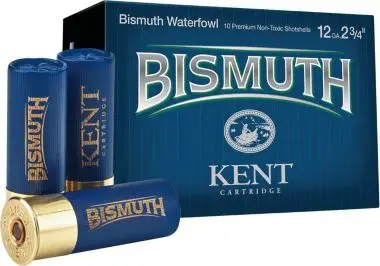|
Kent Cartridge: The Return of Bismuth Shot  Steel shot has only 70% of the density of lead, which creates a very serious problem. Steel has lower lethal effectiveness and a higher capacity for crippling. It is also so hard that it damages shotgun barrels by pounding out the choke on its violent trip down the barrel. As a result, barrels intended for use with steel shot must be made thicker and heavier, adversely affecting the weight and handling of the gun. Back in January 1993, Ross Seyfried conducted evaluations of bismuth for Petersen's Hunting magazine with positive results. In September 1993, professional ballistician Ed Lowry wrote of the ballistic potential of bismuth shot, noting that bismuth had a clear ballistic advantage over steel. At the time, Lowry wrote that bismuth was the most promising alternative with its advantage of 24% greater density than steel. Additionally, bismuth is a far softer material that does not destroy shotgun barrels. Ed Lowry concludes his treatise by saying, "When that happens, hunters will finally have a substantially superior alternative to the current mix of wildly unpopular and ballistically inferior steel shot loads." The early bismuth loads had manufacturing problems, with difficulty in producing pellets larger than #5 shot and brittleness of the shot itself. Kent has refined the manufacturing process, apparently addressed the brittleness, and the Kent Bismuth loads have just gone into production. The ideal shell for many applications looks to be Kent C122BNT36-4, which is a 2-3/4 inch shell, #4 shot, 1350 fps velocity, with a 1-1/4 ounce payload. It should be ideal for ducks and pheasants alike.  Above is the comparison I have run between the now-banned for waterfowl (and in some areas most everything) lead #5 shot at 1330 fps, the three inch steel #2 1400 fps load, and the new Kent Bismuth #4 load at 1350 fps, all with 1-1/4 ounce payloads. Although lead shot remains the best performer in all respects (including price), the Kent Bismuth load soundly tramples the steel load in pellet count, gel penetration, energy and energy density at 40 yards. Unlike several molded composite tungsten shot types, the Kent Bismuth shot is spherical without the increased air drag of wide belts around the shot pellets. The four dollar a shot Hevi-Shot "Classic Doubles" shells were some of the most pathetically poor patterning loads I have ever tested. If you cut open some shells, as I did, the reason is not hard to figure out. The Classic Doubles shot is no denser than bismuth, featuring not only truly abysmal patterns, but a ridiculous price. Bismuth is choked essentially like lead and is safe for lead-only barrels and chokes, unlike many tungsten-based shot types. While many folks have been unhappy with steel and rightly so, due to the cost of tungsten many tungsten shells have to be priced at a level that many hunters have demonstrated that they are unwilling to pay. However, while the good stuff is rarely free, even the crummiest of steel shotshells are a very long way from free, either. The Kent loads hit the bull's eye in price to performance ratio. Rather than the $4 - $5 a shell of some turkey loads, a 1-1/6 ounce payload of #5 bismuth runs about $17 for a box of ten in 12 gauge, or $1.70 a shell. The load I am using, 1-1/4 ounce of #4 shot, runs approximately $2 a shell. Prices do vary for steel, but around $1 a shell for a premium steel load is not unusual. Is twice the price per shell worth it to you for cleaner kills, less shots fired, more range and less abuse to your shotgun than steel? For many hunters, I suspect that the answer is going to be, "absolutely." As a practical matter, assume that you want a minimum of 1.75 inches of ballistic gelatin penetration for pheasant. This cannot be exact, for gel penetration does not consider feathers, much less breaking bones. It is a comparative simulant for soft tissue only. If you are using #2 steel shot at 1400 fps, you are out of gas at 35 yards. With the lower recoil 1350 fps Kent Bismuth #4 load, you are good past 41 yards. #4 bismuth has better penetration at all ranges than #2 steel. In addition, a 1-1/4 ounce load of #4 bismuth has 24.5% more pellets than 1-1/4 ounces of #2 steel. If you are sick of the poor ballistic performance of steel (why wouldn't you be?) and can afford to pay twice the price for your shotgun shells, the new Kent Bismuth loads just made steel shot obsolete. |